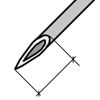Bevel: Difference between revisions
Jump to navigation
Jump to search
(Created page with "<html><div class="mw-content-ltr" dir="ltr" id="mw-content-text" lang="en"><div class="floatright"><a class="image" href="/index.php?title=File:Bevel-1.jpg"><img alt="Bevel-1.jpg" height="100" src="/images/4/44/Bevel-1.jpg" width="100"/></a></div> <p>The <b>bevel</b> of the <a class="mw-redirect" href="/index.php?title=Piercing_needle" title="Piercing needle">piercing needle</a> is its cutting edge. It is made by a flat angled grind across a piece of surgical tubing. A t...") |
(Page conversion via llm-mediawiki-rev -jwm) |
||
| Line 1: | Line 1: | ||
[[File:Bevel-1.jpg|right|100px]] | |||
The '''bevel''' of the [[Piercing needle|piercing needle]] is its cutting edge. It is made by a flat angled grind across a piece of surgical tubing. A tri-bevel needle involves three different cuts at slightly different angles. A bevel needs to be long enough so that it cuts and lifts the tissue rather than coring it out like a [[Dermal punch|dermal punch]]. In addition, the rear angle of the bevel needs to be such that the back half of the bevel does not "catch" the skin as it enters the body. | |||
Latest revision as of 00:21, 17 September 2023
The bevel of the piercing needle is its cutting edge. It is made by a flat angled grind across a piece of surgical tubing. A tri-bevel needle involves three different cuts at slightly different angles. A bevel needs to be long enough so that it cuts and lifts the tissue rather than coring it out like a dermal punch. In addition, the rear angle of the bevel needs to be such that the back half of the bevel does not "catch" the skin as it enters the body.
